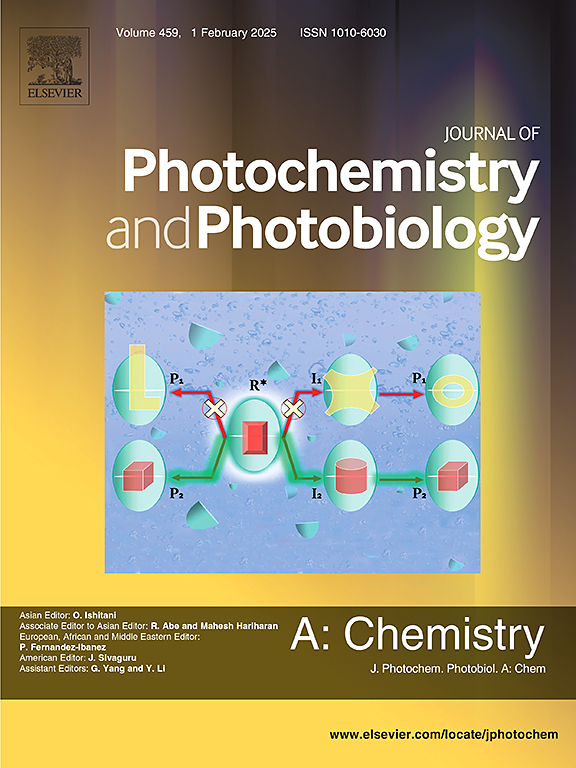Dual-Functional 2D-3D Zn2In2S5 for photocatalytic degradation of azo dye and hydrogen production
IF 4.1
3区 化学
Q2 CHEMISTRY, PHYSICAL
Journal of Photochemistry and Photobiology A-chemistry
Pub Date : 2025-06-04
DOI:10.1016/j.jphotochem.2025.116542
引用次数: 0
Abstract
In this study, we synthesized a two-dimensional-three-dimensional (2D-3D) flower-like Zn2In2S5 (ZIS225) photocatalyst via the hydrothermal method. The photocatalytic performance of ZIS225 was systematically evaluated for the degradation of methyl orange (MO) and hydrogen production under visible light irradiation. ZIS225 achieved a 100 % degradation rate of MO within 60 min, with a reaction rate constant of 6.11 h−1, significantly outperforming commercial anatase TiO2 (degradation rate of 42.7 % and reaction rate constant of 0.54 h−1). Moreover, ZIS225 demonstrated the ability to simultaneously degrade MO and produce hydrogen, with a hydrogen production rate of 4.9 μmol g−1h−1 and a MO degradation rate of 99.7 %. The hydrogen production rate increased to 35.3 μmol g−1h−1 upon in-situ photodeposition of 1 % Pt, maintaining stable performance over three cycles. Photoelectrochemical and electron paramagnetic resonance (EPR) analyses identified superoxide radicals (•O2−) and photogenerated holes (h+) as the primary active species. This research provides valuable insights for the development of efficient photocatalytic materials and offers technical references for dye pollution treatment and clean energy conversion.
双功能2D-3D Zn2In2S5光催化降解偶氮染料和制氢
在这项研究中,我们通过水热法合成了一种二维三维(2D-3D)花状Zn2In2S5 (ZIS225)光催化剂。系统评价了ZIS225在可见光照射下降解甲基橙(MO)和产氢的光催化性能。ZIS225在60 min内达到100%的MO降解率,反应速率常数为6.11 h−1,明显优于商用锐钛矿TiO2(降解率为42.7%,反应速率常数为0.54 h−1)。此外,ZIS225具有同时降解MO和产氢的能力,产氢率为4.9 μmol g−1h−1,MO降解率为99.7%。在1% Pt的原位光沉积下,产氢率提高到35.3 μmol g−1h−1,在3个周期内保持稳定的性能。光电化学和电子顺磁共振(EPR)分析发现超氧自由基(•O2−)和光生空穴(h+)是主要的活性物质。该研究为高效光催化材料的开发提供了有价值的见解,为染料污染处理和清洁能源转化提供了技术参考。
本文章由计算机程序翻译,如有差异,请以英文原文为准。
求助全文
约1分钟内获得全文
求助全文
来源期刊
CiteScore
7.90
自引率
7.00%
发文量
580
审稿时长
48 days
期刊介绍:
JPPA publishes the results of fundamental studies on all aspects of chemical phenomena induced by interactions between light and molecules/matter of all kinds.
All systems capable of being described at the molecular or integrated multimolecular level are appropriate for the journal. This includes all molecular chemical species as well as biomolecular, supramolecular, polymer and other macromolecular systems, as well as solid state photochemistry. In addition, the journal publishes studies of semiconductor and other photoactive organic and inorganic materials, photocatalysis (organic, inorganic, supramolecular and superconductor).
The scope includes condensed and gas phase photochemistry, as well as synchrotron radiation chemistry. A broad range of processes and techniques in photochemistry are covered such as light induced energy, electron and proton transfer; nonlinear photochemical behavior; mechanistic investigation of photochemical reactions and identification of the products of photochemical reactions; quantum yield determinations and measurements of rate constants for primary and secondary photochemical processes; steady-state and time-resolved emission, ultrafast spectroscopic methods, single molecule spectroscopy, time resolved X-ray diffraction, luminescence microscopy, and scattering spectroscopy applied to photochemistry. Papers in emerging and applied areas such as luminescent sensors, electroluminescence, solar energy conversion, atmospheric photochemistry, environmental remediation, and related photocatalytic chemistry are also welcome.

 求助内容:
求助内容: 应助结果提醒方式:
应助结果提醒方式:


